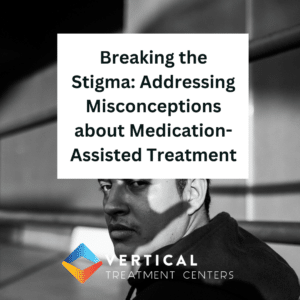
Breaking the Stigma: Addressing Misconceptions about Medication-Assisted Treatment
Medication-Assisted Treatment (MAT) is an evidence-based approach to treating addiction that combines medication and therapy to help individuals achieve and sustain recovery. Despite its proven effectiveness, there are still misconceptions and stigmas surrounding MAT. In this blog post, we will debunk common misconceptions and address the stigma associated with MAT to promote a better understanding and acceptance of this valuable treatment option.
Understanding Medication-Assisted Treatment (MAT)
MAT involves the use of FDA-approved medications, such as methadone, buprenorphine, or naltrexone, in combination with counseling and behavioral therapies. It is primarily used for opioid and alcohol addiction treatment. MAT works by reducing withdrawal symptoms, minimizing cravings, and preventing relapse, allowing individuals to focus on their recovery journey.
Myth: Medication-Assisted Treatment Equates to Trading One Addiction for Another
One prevalent misconception about MAT is that it substitutes one addiction for another. This is simply not true. The medications used in MAT are carefully prescribed and monitored by healthcare professionals to ensure safety and effectiveness. Unlike illicit substances, MAT medications are administered in controlled doses, do not produce euphoria, and enable individuals to function normally.
Myth: Medication-Assisted Treatment is Just a Quick Fix
Some people believe that MAT is a short-term solution and doesn’t address the underlying issues leading to addiction. However, MAT is a comprehensive treatment approach that combines medication with counseling and behavioral therapies. It supports individuals not only in overcoming physical dependence but also in addressing the psychological and social factors contributing to addiction.
Myth: Medication-Assisted Treatment is a Crutch and Hinders True Recovery
Another misconception is that MAT is a crutch that hinders individuals from achieving genuine recovery. In reality, MAT provides the stability necessary for individuals to focus on therapy, develop healthy coping mechanisms, and make positive lifestyle changes. It serves as a foundation for building a strong recovery framework and can be gradually tapered off under medical supervision.
Myth: Medication-Assisted Treatment is Only for Severe Cases
MAT is not limited to severe addiction cases. It can benefit individuals with varying levels of substance use disorders. MAT is a flexible treatment option that can be tailored to individual needs, whether it is used as a long-term maintenance strategy or a short-term intervention during the early stages of recovery.
The Importance of Combining Medication with Therapy
MAT is most effective when combined with counseling and behavioral therapies. Therapy helps individuals address the root causes of addiction, develop coping strategies, and make long-lasting changes. The combination of medication and therapy addresses both the physiological and psychological aspects of addiction, increasing the chances of sustained recovery.
Conclusion
Breaking the stigma surrounding Medication-Assisted Treatment (MAT) is crucial for promoting an accurate understanding of this evidence-based approach to addiction treatment. Debunking misconceptions, such as the belief that MAT substitutes one addiction for another or that it is a quick fix, is vital in encouraging individuals to seek out this valuable treatment option. MAT, when combined with counseling and therapy, provides a comprehensive and effective strategy for overcoming addiction and achieving long-term recovery.